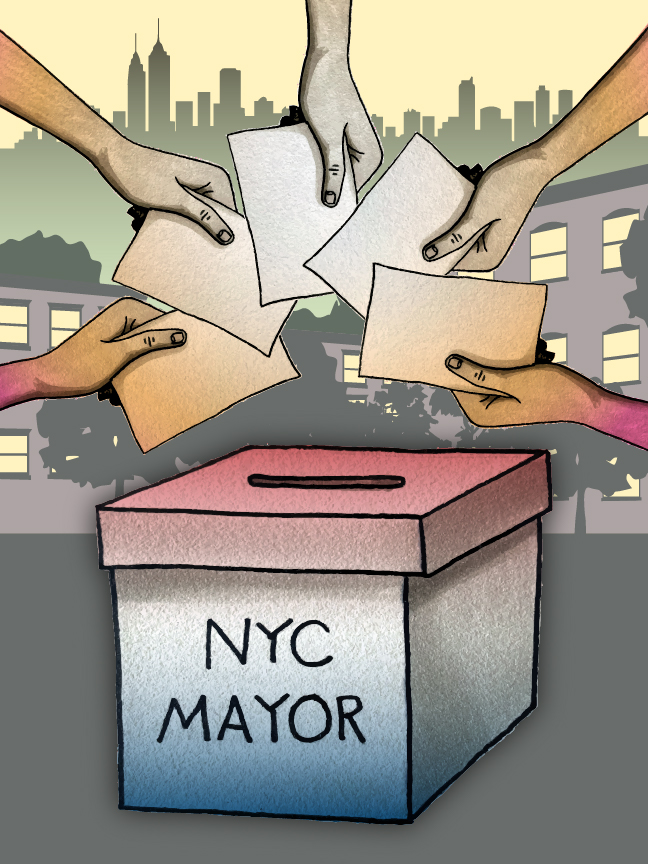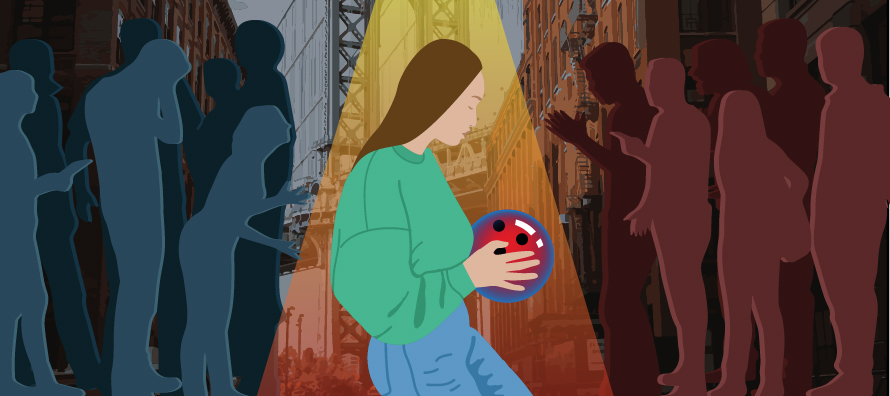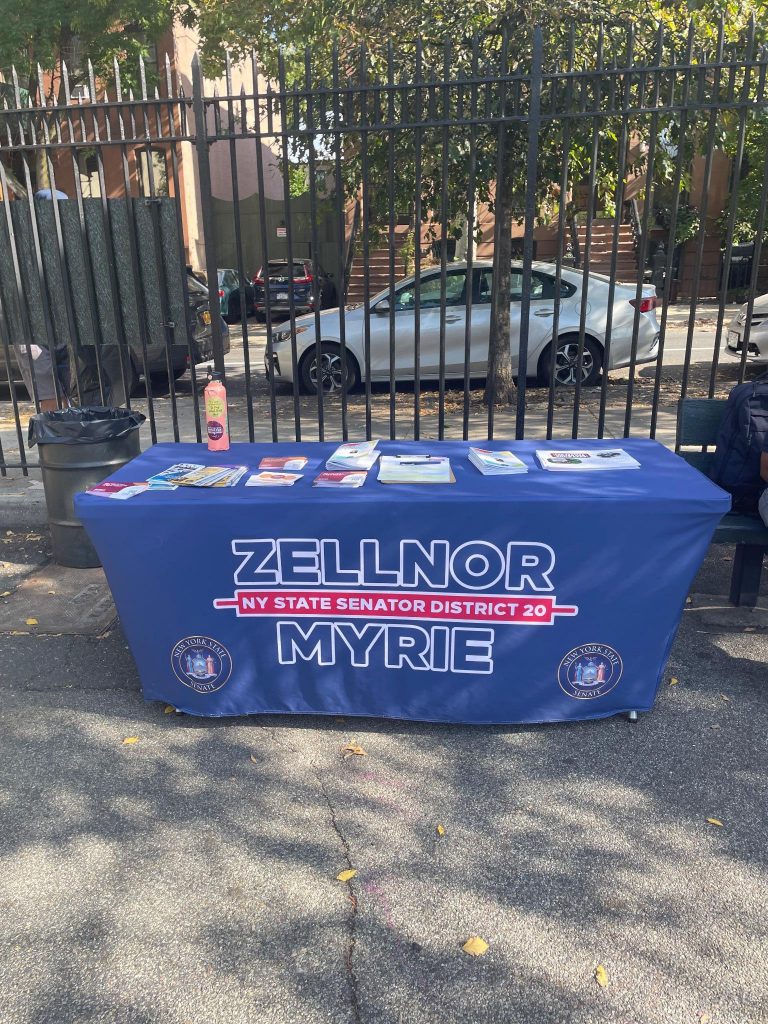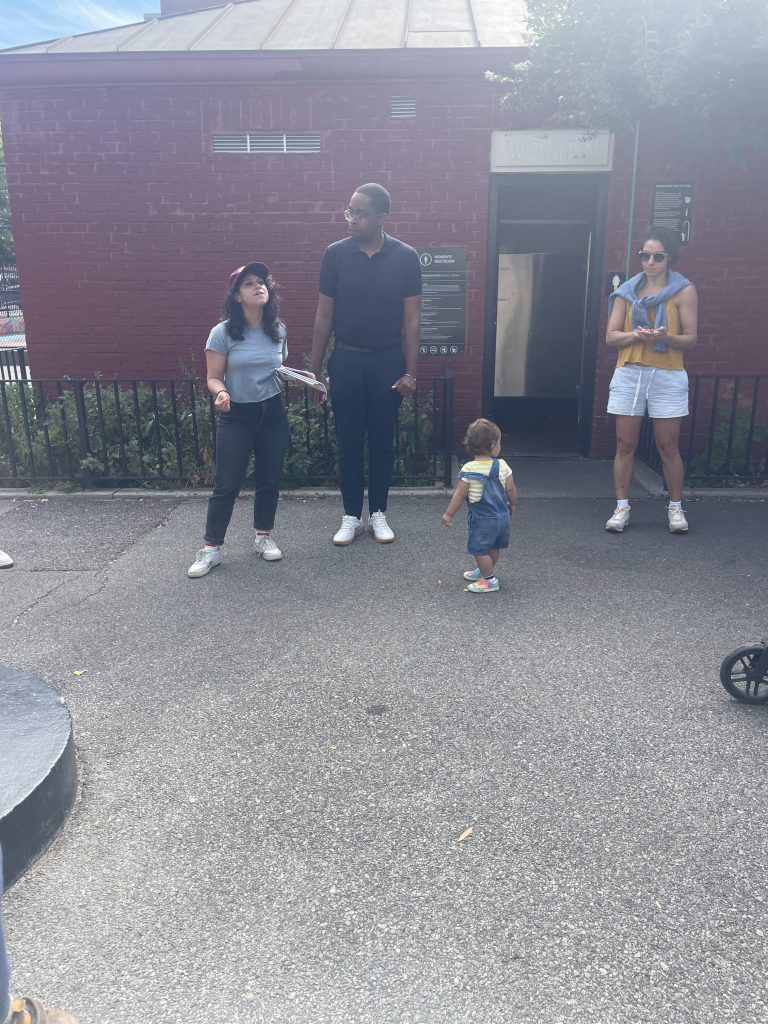Like millions of other children of the 1970’s, I’m a huge Star Wars fan. I always wanted to be a member of the Rebel Alliance. I wanted to be friends with Wookies. I really wanted to be a Jedi. I wanted to use my special powers to challenge oppressive, imperial forces, and ultimately save the day. I didn’t think that in my middle-aged existence I would be trying to do just that. But here we are.
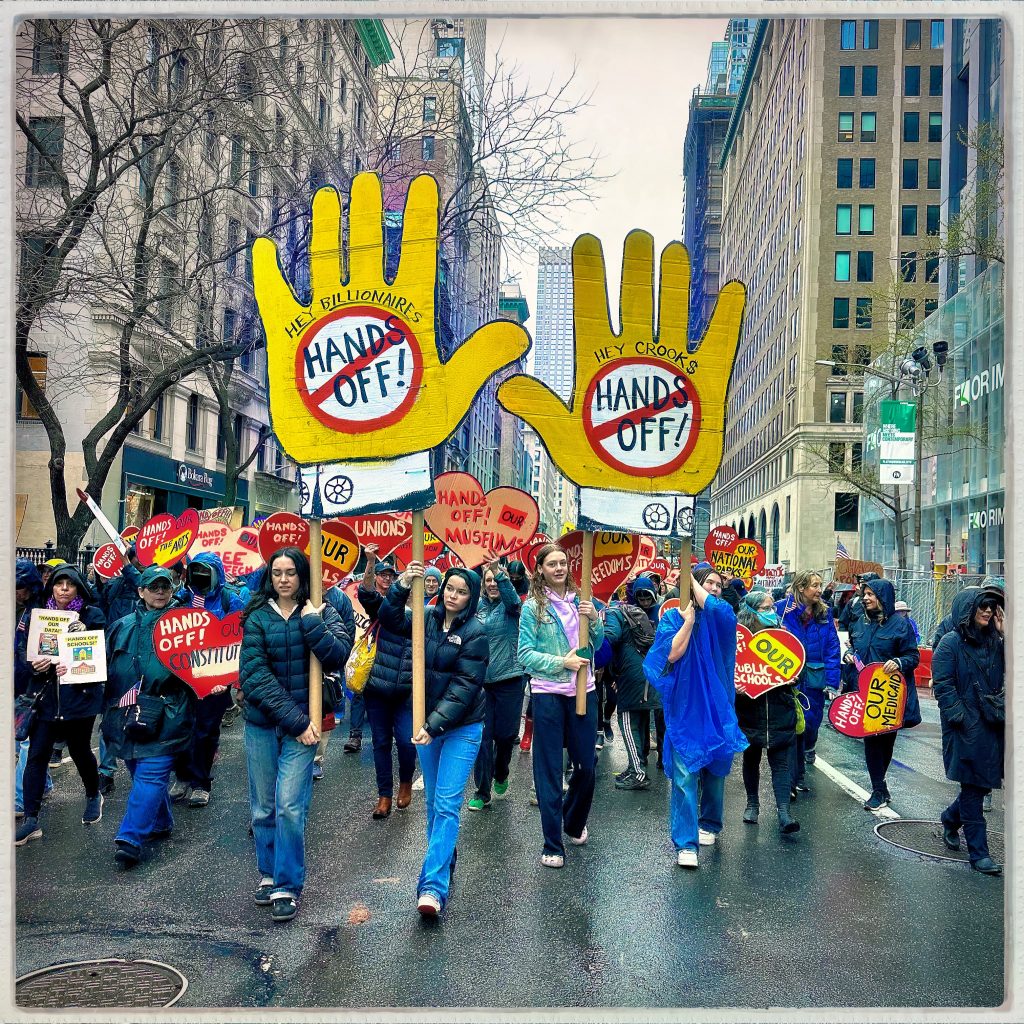
Not even six months into this second Trump presidential term, and our democracy is waning. There is a daily barrage of devastating policies being proposed or effectuated, targeted at the most vulnerable of those in the United States of America. The federal legislature has proved inept at thwarting chaos. The New York State legislature and most of our local elected officials are busy playing defense. Mayor Adams, on the other hand, is busy cozying up to this administration, while the NYPD assists ICE to detain and deport our neighbors when they show up for their scheduled hearings in US Immigration Court. The courts are overwhelmed, and holding on by a thread. The people, though, seem to be rising up. At least that’s the vibe around here.
Park Slope, in particular, seems to be showing up. Many of us are organizing, marching, protesting, planning, making phone calls, sending emails, making signs, chanting, and disrupting. We’re also connecting with each other.
The rebellious actions I’m participating in these days are nothing like hiding the Death Star plans in my favorite droid, but they still feel important. On April 5, 2025, a friend and I joined dozens of others on the 7th Avenue F train platform to catch a ride to the Hands Off march from Bryant Park to Madison Square. The NYC Hands Off march was part of a larger effort that included over 1400 actions in all 50 states, involving an estimated 3-5 million participants. The Hands Off protests are the largest coordinated display of public resistance against the Trump administration, so far. I made my own “Hands Off Our Votes” sign that is now visible in the front window of my home. Park Slope folx of all generations were on that F train platform with their own signs on hand, as we smiled and chatted with each other on the trip into Manhattan.
When my friend and I joined up with the Indivisible Brooklyn group, she was handed one of the beautiful heart-shaped “Hands Off” signs that our Indivisible group had made for the event. Since our group led the march, those signs were prominently highlighted in subsequent media and social media coverage.
As we walked down 5th Avenue, we took pictures of the onlookers, as those onlookers took pictures of us. Dozens of construction workers, standing upon scaffolding, used their phones to take pictures with their phones. The workers were reaching down off the scaffolding to do marchers the favor of snapping pics of the event on marchers’ phones from the higher elevation. Supporters were cheering and waving from windows high above 5th avenue. Reflecting on the electric and inspirational energy of that not-so-distant day, I almost forgot that it was cold and drizzling. But the weather surely was not as hazardous as that on the planet Hoth; no need to split open a dead Tauntaun to warm up a friend with hypothermia, just pop into Eataly when you get to 23rd Street until you can feel your toes again.
Since our group led the march, we had no idea the magnitude of the turnout behind us. Around the time we reached Madison Square Park, about an hour after starting to walk, I received a call from my sisters. They were also at the march, and calling to see where I was, hoping to connect in person. They were still at Bryant Park, waiting to start marching. There were miles of protesters marching in Manhattan that day, estimated at more than 100,000 people. It seems like people are getting involved who have never taken part in resistance efforts before. Maybe some of these newcomers will be like Han Solo, and get connected to a rebel for personal benefit, but ultimately become an iconic hero of the movement.
Large-scale actions, like marches, are a great opportunity to have a shared experience with others who have a similar perspective, and help you realize you’re not alone. Together, even the diminutive amongst us can get big things done. Like when Princess Leia befriends Wicket, eventually joining rebel and Ewok forces to take down the Death Star’s shield generator on Endor, though definitely not as dangerous.
Modest actions can be just as powerful, and maybe even more important. That has been my experience at the local “Tesla Takedown” protests. I live around the corner from the new-ish Gowanus Tesla dealership on the corner of 9th Street at 2nd Avenue. Since early March, dozens to hundreds of protesters have shown up at that spot between 12-2pm every Saturday. These “Tesla Takedown” protests are happening at Tesla dealerships across the country on a regular basis to bring attention to the madness of a billionaire and his goons accessing our private information as they strip the federal government for parts.
Around 12:05 pm every Saturday, my family wonders why the traffic is so noisy outside. “So much honking…” And then one of us realizes that it’s time for me to grab my signs and walk over to join the protest. Protesters line each side of 9th Street holding signs like “Nobody Voted for Musk”, “Hey Rich Guy! Get Out of Our Data”, “Make Fascism Wrong Again”, and my personal favorite: “P.S. Your Logo Looks Like an IUD”. The signs that get the biggest response from passersby are of the “Honk for Democracy” and “Honk If You Hate Musk” variety. The Tesla protest crew is friendly, and pretty tame. We chant, usually in call and response format. Sometimes we direct our chants into the Tesla showroom windows, but there aren’t usually many people in there, other than the staff.
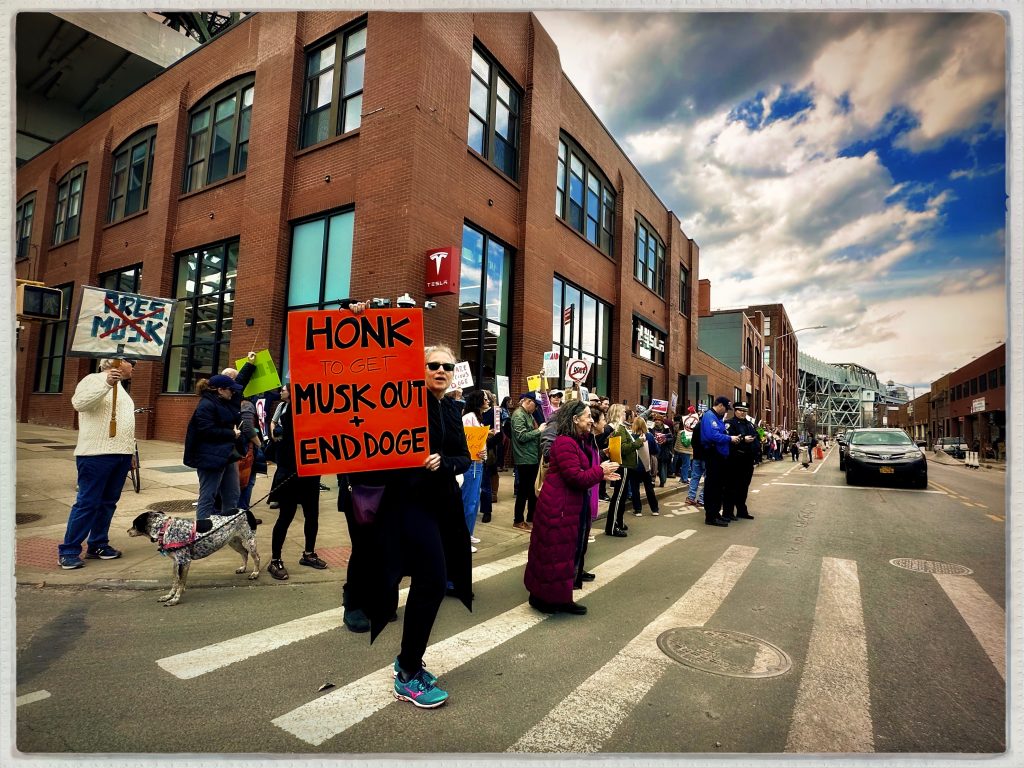
We celebrate every single passing vehicle that honks in support of our cause. Subarus seem to be the most likely to honk, along with hybrid and electric vehicles. You’d be surprised how many Teslas actually honk in support, including some driven by Tesla employees. Citi-bike riders ring their bells, as they pedal by. Our crowd goes particularly wild when MTA buses and truck drivers use their loud horns in solidarity.
Support for the Tesla actions are not universal. Some Tesla owners, arriving for service, cower or crow as they pass us. Every week there is a police presence. There is at least one marked car, and two officers. One particular week, it seemed that the police knew something the protesters didn’t, because they had 2 brand new paddy wagons waiting for occupation on 2nd Avenue. The paddy wagons drove away as empty as they arrived. As I said, this crowd is not rowdy, but I guess groups challenging existing power structures makes people in places of power nervous.
At a particularly populated protest, I noticed a young man without a sign, who wasn’t engaging with others; not chanting. He had a small camera in his hand, and seemed to be taking pictures from chest level, so as not to draw attention. I pointed him out to a friend, and she eventually approached him and engaged with him. He said he was not in support of the effort, and was there to document what was happening, just in case. I guess the experience bored him, because I haven’t seen him since.
On a recent weekend, unable to make the Gowanus “Tesla Takedown”, I found what I hoped would be a similar opportunity in another part of Brooklyn. I had heard from a fellow rebel about short Friday protests at Ocean Parkway and Church Avenue. I showed up, introduced myself, and grabbed a pre-made sign: “People Over Billionaires”. I stood on the southbound side of Ocean Parkway, ready to engage with commuters headed home deep into Brooklyn after the long week. Almost all drivers and passengers took a look. Many waved, showed thumbs up, and/or honked their cars, which was encouraging. But, in that part of Brooklyn, unlike Gowanus, there were people in cars passing by chanting “Trump! Trump! Trump!” and “I love Trump!” out their windows at us. A bunch of people flipped me off. Support for a rebellion is never universal. A significant proportion of the population in the Star Wars universe had to support the creation of the Galactic Empire in order for the Emperor to take control, right?
Marches and protests are not designed to make immediate change, but to raise awareness, and offer opportunities to get engaged in a cause. Whether you go alone, or with people you know, you get to connect with others. At a Tesla protest, I met another woman with a “Honk” sign. She was new to Brooklyn, having lived most recently in California, but grew up in Texas. She told me how lucky she felt to be at this protest, getting supportive responses from passersby, and connecting with similarly minded people. She explained that she used to participate in social justice actions in Texas, but that actively engaging in those events was risky.
The truest rebels are NOT those of us showing up in Midtown Manhattan, Park Slope, Gowanus, or Kensington. The heart of the resistance are people who are showing up in places where it’s not humorous and slightly uncomfortable to get flipped off by a stranger in a passing car, but potentially dangerous; where dozens gather on the side of the road to bring attention to the fascism taking root in Washington, D.C., only to be met with a counter-protest with hateful, bigoted signs. To make it safer for the truest of rebels, and ultimately worth their risk, those of us with the privilege and power need to be stepping it up.
On the first Sunday of May, I was leaving my house to attend a planning meeting of similarly minded resistance members. When I told my teenager where I was going and when I’d be back, he noted the date: 5/4, Star Wars Day. And as I walked out the door he called: “May the Fourth be with you!” I hope the spirit of rebellion will find us all on every day that is left of this administration.

